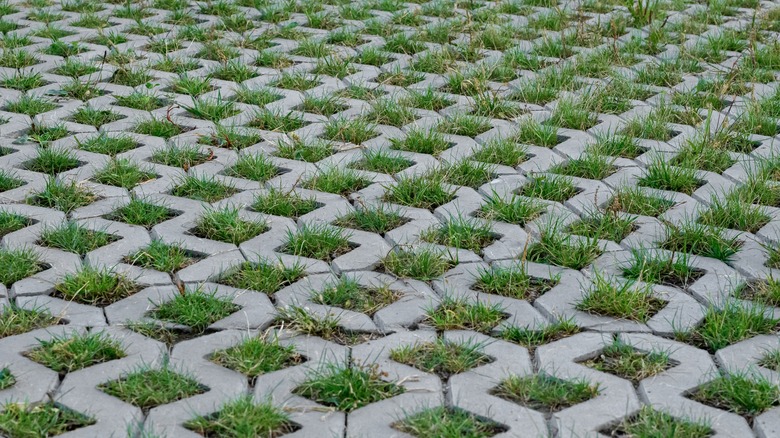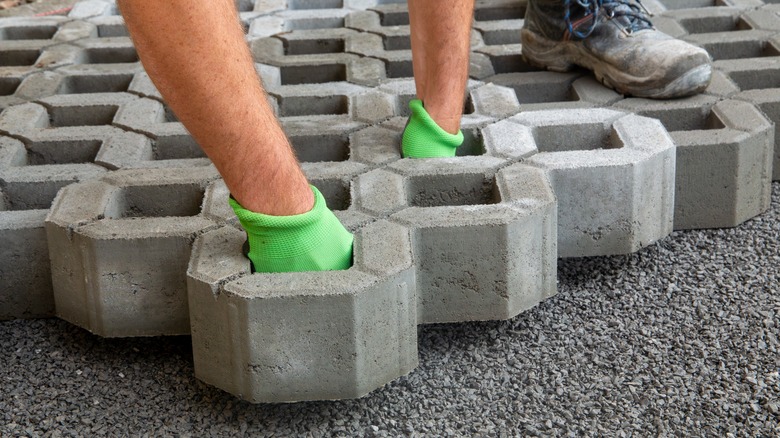Seamlessly Integrate Your Driveway With Your Lawn Using A Grass Paver System
We may receive a commission on purchases made from links.
Do you shudder at the thought of a giant asphalt or concrete driveway taking over precious green space in front of your home? As unsightly as they are, these hardscaping elements are an unfortunate necessity for almost any home with cars and a garage. But what if we told you that there's a way to connect the roadway to your garage door without reducing the amount of green space in the front yard? By using a grass paver system (also known as a reinforced grass driveway or turf paver blocks), you can seamlessly integrate the lawn and the driveway without relying on traditional asphalt, concrete, or stone pavers to do the job.
Grass pavers are a paving system comprising a plastic or concrete grid with soil and living grass in each module. The grid sits on top of a properly prepared substrate layer and is filled with soil, which is then seeded. The seedlings germinate and mature just as they would on your lawn. The grid protects the roots of the grass growing inside the modules from the pressures exerted by vehicular traffic. This way, you can drive your car over the grass pavers or park it on top of them without risking damage to the grass. Best of all, you can maintain the grass growing in these pavers just as you'd maintain your lawn. Below, we outline the pros and cons of having a grass paver system and walk you through the paver installation steps.
Weighing the advantages and disadvantages of a grass paver system
One obvious benefit of a grass paver system is that it keeps you from sacrificing green space to accommodate vehicles. Visually, the grass pavers are virtually indistinguishable from the adjacent lawn, so the entire space in front of your house remains green. Apart from aesthetics, grass pavers are more effective at stormwater management than their concrete or asphalt counterparts. While hardscaped driveways often allow rainwater to pool, grass pavers are permeable and able to absorb it. By soaking up the rainwater, grass pavers prevent it from flowing freely through the streets and carrying contaminants like pesticides, herbicides, and fertilizer into our waterways.
Another benefit of a reinforced grass driveway is that it helps keep your property cool on hot summer days. Asphalt and concrete driveways absorb solar radiation, then slowly release heat throughout the day in a phenomenon known as the "heat island effect." Meanwhile, a natural landscape like a grass driveway does not have the same capacity to take in and re-emit radiant heat.
Despite their many benefits, reinforced grass driveways come with a few drawbacks. For one, grass pavers need maintenance — just like your lawn. You'll need to mow the grass, fertilize it, overseed it as needed, and keep it weed-free. Also, you may find that the grass pavers feel a bit bumpier under your vehicle than a smooth, concrete, or asphalt surface would. Finally, the grid that comprises the grass paver system doesn't last as long as a traditional driveway. Even so, the average lifespan of a grass paver system is about 10 years.
How to install a grass paver system on your property
Installing a grass paver system isn't that different from laying down any other type of paver. First things first, you need to clear the top layer of the soil, along with any plants, their roots, and debris. Then, excavate to the desired depth, taking grading into account. Even though grass pavers absorb runoff, you still want the driveway to slope away from your garage so that a heavy downpour can't cause water to flow toward the home's foundation. When considering the excavation depth, you'll have to account for the thickness of the pavers themselves (they're usually 4 inches thick) and the gravel layer beneath them. Since the driveway is designed for vehicular traffic, you'll want 4 to 6 inches of crushed stone under the pavers. So, you're looking at a total depth of about 10 inches.
Once the excavation is complete, compact the soil using a tamper tool. Then, fill the excavated area with gravel and compact it once again. At this point, you can lay down a geotextile fabric, Towallmark Geotextile Landscape Fabric, on top of the gravel — it will help keep weeds from appearing in the paver system. Next, follow the manufacturer's instructions to install the pavers down and interlock them to form a continuous grid. With the pavers in place, fill the grid with soil, then sow the grass seeds. That's it — once the seedlings germinate, you've got your grass paver driveway!


